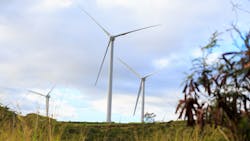For more than 10 years, Hawaii has been reimagining and implementing a vision for what a new, clean energy paradigm might look like. Hawaii’s visionary ambitions for its energy sector can be summarized in two facts:
- In 2018, Hawaii relied on petroleum to generate over 60% of its electricity.
- By 2045, Hawaii aims to generate 100% of its electricity from renewables.
In 2015, Hawaii was the first U.S. state to proclaim a 100% renewable energy target. It led the way for more than 100 other jurisdictions to follow suit with similar goals. Now as policymakers and energy stakeholders grapple with implementation of these targets, all eyes remain on Hawaii to demonstrate strategies to achieve 100%.
Rocky Mountain Institute’s (RMI’s) recent report Powering Paradise shines a light on replicable elements of Hawaii’s approach to the clean energy transition. The report is a postcard from the future describing Hawaii’s experience and offering lessons for those pursuing energy system transformation.
Energy systems are complex, whether on the Hawaiian Islands or on the mainland. No one person or organization can transition the entire system or influence change. It takes a combination of market forces, enabling policy, updated regulations and, importantly, innovation and resolve.
Market
In 2011, an earthquake caused the Fukushima nuclear power disaster and forced Japan to shut down its nuclear fleet. As Japan ramped up production from oil-fired power plants to make up the generation shortfall, oil demand and prices spiked. At the time, Hawaii relied on oil for 80% of its electricity generation, so as oil prices rose, so did retail electricity rates. Monthly utility bills soared, and Hawaii’s leadership felt a pressing need to do something.
This prompted state leadership to refocus attention on the goals of a 2008 partnership between Hawaii and the U.S. Department of Energy known as the Hawaii Clean Energy Initiative (HCEI). HCEI envisioned that Hawaii would become an innovation test bed for new technologies and business models to lead the transformation of the energy sector into one based on renewable energy and energy efficiency.
Policy
While market forces catalyzed change, a new policy construct was needed to capture that lightning in a bottle. Through progressive legislative milestones — from the renewable portfolio standard to a more recent zero emissions clean economy target — Hawaii’s legislature has created the North Star to orient state efforts toward decarbonization. Thanks to a portfolio of ambitious energy legislation, the goal of energy transition has survived election cycles and changing administrations to remain at the forefront of Hawaii’s culture of change.
Regulatory
Policy changes and aspirations can be meaningless without the muscle of regulators to move change through the system. For example, the Hawaii Public Utilities Commission (PUC) is leading a landmark proceeding focused on performance-based regulation (PBR) to align utility business incentives with state policy goals. The PUC is similarly leading a range of other energy reforms to proactively steward the state’s energy transition.
A key area of focus for the PUC has been how to fully leverage all the distributed energy resources that residents have adopted, especially rooftop PV. Since electricity rates spiked in 2011, Hawaii residents turned to increasingly cost-competitive solar power. Today, one out of every three single-family homes on Oahu has solar on its rooftop, and distributed solar is the leading source of clean energy in the state.
Utility
Utilities can be innovators or implementors. Hawaii’s utilities are both. Hawaii utilities have adapted to the pace of change and embraced the goal of 100% renewable energy. Electric system planning and operations are being redesigned to enable customer choice and manage two-way power flows. An active proceeding on integrated grid planning is working to optimize the beneficial integration of distributed assets and harmonize traditionally separate planning processes for the bulk and distribution systems.
Lessons from Hawaii’s Experience
Although Hawaii’s story is still being written, three lessons are emerging from the collective efforts of the state’s energy community:
- A willingness to try — Hawaii is constantly pushing boundaries, without always having a clear script for where it will go. Others can learn from Hawaii’s missteps, but should also be emboldened to take their own risks, assured that rapid feedback loops will accelerate rather than impede progress.
- Clear guidance from leadership — From the justification for the 100% renewable energy goal, to the framing for the utility of the future and expectations for stakeholder engagement in regulatory proceedings, Hawaii demonstrates the importance of establishing reasoned, clear, and compelling intentions for the energy transition.
- Stakeholder engagement — As it stepped into the unknown, Hawaii has consistently crowdsourced invaluable wisdom from local stakeholders, as well as drawn upon national and international experience. Ensuring broad support for its actions has been critical for maintaining momentum and making progress toward goals that benefit everyone.
About the Author
Jason Price
Jason Price works in Rocky Mountain Institute's (RMI) electricity practice, where he focuses on distributed energy resources (DER) deployment and integrated grid planning.
